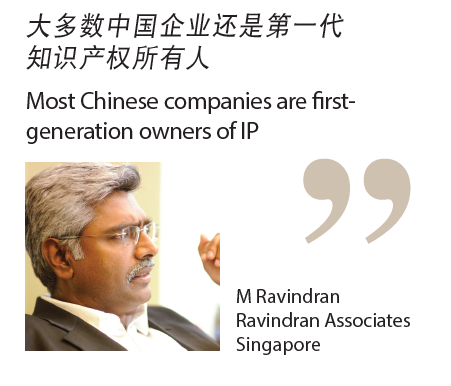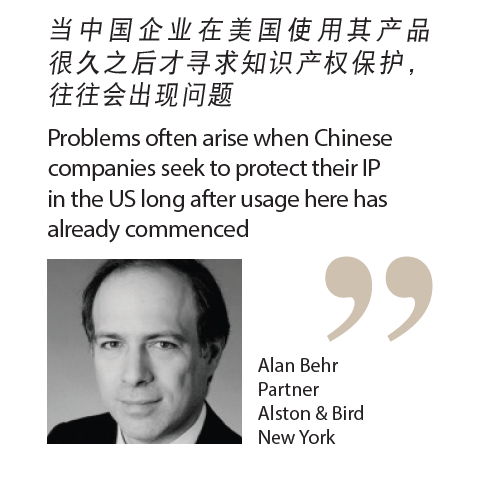Chinese companies with a desire to go multinational face many obstacles. Some have encountered a problem they did not expect: violations of their intellectual property rights
By Alfred Romann
You would be forgiven for thinking that whenever China is mentioned in the same breath as intellectual property, the topic of conversation will be infringement by a Chinese party.
China is among the most pirate-infested IP jurisdictions. This month, the office of the US Trade Representative included China along with countries such as Algeria, India, Indonesia, Pakistan, Russia and Venezuela in its latest priority watch list of nations it says don’t sufficiently guard US IP rights.
But nowadays, increasing numbers of Chinese companies are exporting valuable niche products and services with recognizable brands, patents and trade marks. According to the World Intellectual Property Organization (WIPO), China submitted 7,946 international patent applications in 2009. The figure is dwarfed by the 53,000 patents applied for from the United States, but is the fifth-highest number worldwide and represents an increase of nearly 30% over 2008 amid a global 5% decline in patent applications.
The trend is clear. Chinese companies are increasingly trying to protect their own IP assets. “They want to use the IP system to get a competitive advantage,” says Stephen Haley, a London partner at Gill Jennings & Every, who specializes in information technology and engineering patents.

Chinese companies as victims
As Chinese companies spread abroad, they are facing issues more commonly encountered by their foreign competitors within China. In Thailand, for example, an angry former distributor of products for a Chinese telecoms manufacturer registered the company’s name as its own trade mark, says Nettaya Warncke of Domnern Somgiat & Boonma in Bangkok.
Matthew Hall, a Sydney partner at Swaab Attorneys, says Chinese IP owners are increasingly attempting to establish first use, overcome brand “squatters”, establish proper protection for translations and transliterations of Chinese marks, understand the difference between trade marks and registered business names and deal with transfer pricing issues.
Chinese companies have scored some recent successes in IP disputes with European rivals. Germany’s Daimler sued Sany Group, a Changsha-based maker of construction equipment that recently moved into Europe. Daimler filed a suit in the High Court of England and Wales, complaining that Sany’s logo was too similar to its own Mercedes-Benz “three-pointed-star” trade mark. A judge dismissed Daimler’s claim in a 33-page ruling.
In another case, Dewey & LeBoeuf worked with a Chinese software company against a competitor that had copied its IP in a software application and the shape of an electronic device. An Italian court granted an order against the infringer, says Milan partner Marco Consonni. (Despite this success, Consonni adds, “Chinese companies are usually worried about the length of our court cases.”)

A fundamental point which is often overlooked is the importance of keeping track of actual ownership. “A number of Chinese companies are not performing proper trade mark clearance searches in Australia to determine if there are any competing businesses in Australia which have protected identical or similar brand names,” says David Stewart, managing director of Wrays Lawyers in Perth.
Laws of the lands
The global IP landscape is governed by a system of international conventions. The Madrid system for the international registration of marks (the Madrid Agreement of 1891 and the Madrid Protocol of 1989) is widely used for trade marks, and most countries are signatories.
For other types of IP, the Berne Convention for the Protection of Literary and Artistic Works, the World Trade Organization’s trade-related aspects of intellectual property rights regime (known as TRIPS) and the Patent Cooperation Treaty (PCT) may apply.
The major international treaties “generally provide for reciprocal rights protection and minimum levels of protection in respect to certain kinds of IP,” says Allison Gibbs-Williams at Eversheds in Johannesburg. However, not all major economies are signatories to the major international conventions. Among the larger economies, Canada, South Africa, Argentina, Thailand and India have yet to join the Madrid Protocol.
Taiwan is one of the few major jurisdictions outside the PCT. This can present some difficulties. “It occurs not rarely that the inventions for which our [mainland] Chinese clients intend to seek protection in Taiwan have lost novelty in view of the publication of a PCT application,” says Patrick Yun of Saint Island International Patent and Law Offices in Taipei. “Chinese companies should be aware that a corresponding patent application must be filed in Taiwan within 12 months from the filing of the PCT or home application.”
Chinese companies may also face particular issues due to the unique relationship between Taiwan and China. “Mutual recognition of priority claim for patent and trade mark applications is not available between Taiwan and China,” says Daisy Wang of Taipei law firm Lee and Li. “The Taiwan government is now amending the Patent Law, Trade Mark Law and Copyright Law, which may result in significant changes to IP practice.”
Even countries that are signatories to international agreements can present local obstacles. In Vietnam, there can be difficulties with overlapping legislation, says Pham Vu Khanh Toan, managing partner of Pham & Associates in Hanoi. “Many issues are not elaborated by the law but regulated by various subordinate regulations, which cannot be tracked by persons who are not acquainted with the Vietnamese legal system,” he says (see The IP world tour on page 42).
Timing of the essence
No matter which country is involved, timing is crucial in the acquisition and registration of IP rights. Argentine firm Palacio & Asociados, for example, works with Sany, telecoms equipment manufacturer Huawei Technologies, car maker Great Wall Motor, computer major Lenovo, herbal medicine manufacturer Yunnan Baiyao and others. “In some locations, they find identical or similar trade marks already registered by their former importers,” says Diego Palacio, one of the firm’s attorneys at law.

Brazil also exemplifies another timing issue common to many emerging economies: backlogs. “There is no political will to straighten out the situation and the backlog continues to increase daily,” says Denis Daniel, a partner at Daniel Abogados in Rio de Janeiro. These backlogs may, for example, stem from a shortage of patent examiners in some areas or a lack of qualified judges.
In Brazil and other South American jurisdictions, lack of foresight often afflicts Chinese IP owners. “The most common problem faced is not having registered IP rights before exporting products to our country or entering into distribution agreements with local companies,” says Marcello do Nascimento of David do Nascimento Advogados in São Paulo.
A local “watch” service can be useful to ensure that infringers, particularly of trade marks, are identified quickly. Both China and the US are “first to file” countries, which means that the first to register has priority rights. “Even if a Chinese company secures a US registration, it could face a cancellation of the registration by a prior user for up to five years after the registration is secured,” says Maureen Beacom Gorman, partner at Davis McGrath in Chicago.
In some emerging markets, concepts of time can frustrate even the most patient of IP rights holders. In Sri Lanka, for example, the National Intellectual Property Office (NIPO) is notoriously slow. The office has embarked on a programme of computerization but “the gargantuan task of data entry is not yet complete, and in certain classes, the examination of pending applications can take several years,” says John Wilson of John Wilson Partners in Colombo.

More fundamentally, some emerging markets around the world are only now beginning to consider trade mark protection, particularly in the least developed countries in Africa. In Nigeria, for example, counterfeiting is rampant and enforcement is lacklustre, says Adeola Olumeyan of Lagos firm Jackson Etti & Edu.
Translation and transliteration
The ever-present need for translation can produce another bottleneck. In Sri Lanka, all applications received are published in English, Sinhala and Tamil but the NIPO has a shortage of translation staff. Language problems compound the local courts’ lack of experience. “IP litigation is relatively uncommon so there is a lack of judicial precedents in areas of uncertainty in the law,” says Wilson.
Other countries have, in addition, local language requirements. South Africa, for example, requires that all documents be in one of the country’s 11 official languages. South Africa also requires documents be authenticated, typically by a notary public, says Gibbs-Williams.
Another problem is a very practical result of how different languages are written. “Transliteration of marks is a broad concern,” says Gorman at Davis McGrath. “Chinese characters, for example, are part of the USPTO design code, and, although they can be searched under the description of the mark, clearance of a Chinese character mark may be more difficult and more expensive,” she adds.
Something similar happens in the Philippines, say IP lawyers. “Chinese trade mark holders who have Chinese characters as part of their trade marks are required to provide the English translation and transliteration of said characters in their trade mark applications,” says Roderick Salazar of Fortun Narvasa & Salazar in Manila.
Cultural barriers
For Chinese companies venturing overseas, IP protection must be approached country by country. “The cultural differences when it comes to negotiations, deals and drafting agreements should not be underestimated and can be a challenge when acquiring IP and negotiating business deals,” says Agnes Andersson, an associate at the IP and technology practice at Setterwalls in Gothenburg. Andersson, nonetheless, is optimistic.“Most Chinese companies appear to understand these challenges and find ways to overcome barriers.”




















